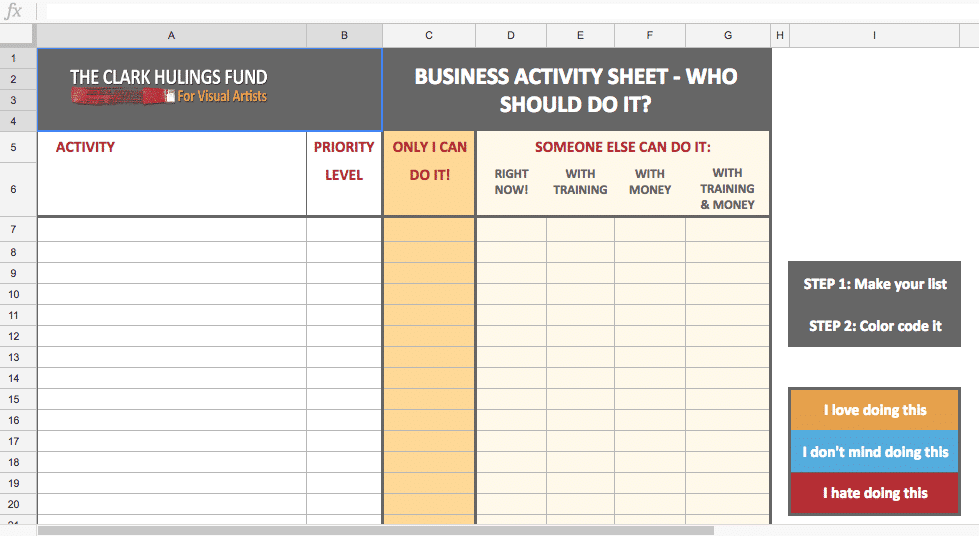Here is a deceptively simple tool that I use with many, many clients, from artists to solopreneurs in other industries, to people at large corporations and non-profits. It’s a useful exercise for just about everyone.
It’s A Spreadsheet!
What I suggest you do when you’re in the right headspace is use this sheet to write down an exhaustive list of the things that have to get done in your business. This sheet is a sample, of course. You’ll want to make your own, and probably complete it electronically, but you could also print this and make copies of it to have enough lines. You can include everything from pieces of your artistic practice (i.e., ordering supplies, stretching canvases, hiring a model) to posting on social media, writing descriptions of your pieces, budgeting, doing research on potential collectors, etc. Include everything that needs to get done in order for you to achieve your goal and do more than maintain the status quo.
1, 2, 3, GO
Then prioritize the activities according to how each will help you accomplish your goal (I suggest 1, 2, 3 or 3, 2, 1, but you can figure that one out on your own). Take your time with this, some things may feel urgent or essential at first, but as you work through the list you might decide they’re not but others unexpectedly are. Think about the dependencies – some tasks might not be important in and of themselves, but they become important when you realize you cannot complete other tasks without having done them first.
Don’t Look at Me!
Now check off the things that only you can do—really challenge yourself on this—are you SURE no one else could do it? Could you train someone else to do it, or hire an expert and pay them to do it? Don’t get hung up on barriers like not having any money to pay or time to train—the whole point here is to imagine a world in which you don’t have to do all of those things yourself. For the purposes of this exercise, the sky’s the limit. You have the money and the time, and the people. Resources are not an issue inside this little vacuum.
Once you’ve prioritized all the items I want you to walk away—leave this alone for a day or two, and then come back and challenge yourself again: what steps did I miss? What could I delegate? How important is each thing? Only move on to the next step when you’re pretty confident you have 90% of it right.
Pick your Drudgery
They say your friends are those whose faults don’t bother you. Well, here you pick the activities that you tolerate best (some people hate to vacuum, others loathe doing the laundry…). Begin by highlighting in one color the items that you enjoy doing (whether someone else can do them or not). Next highlight in a different color the things that you really hate doing. Now use a third color to highlight the things you don’t mind doing—you don’t hate them, you don’t love them.
Sweet Spot
Now you can really start to get a sense of how to organize your business to maximize your studio time AND drive you toward your goal simultaneously. This is how you accelerate your business while continuing to create what matters to you and put it out there so that it can also matter to the rest of us and we can pay you for it. You now have an organized list with which you can take immediate action. You know what you can stop doing now, and you can now develop plans for delegating additional things that you don’t absolutely have to do yourself and that you don’t like to do either. It might take some time to get there, but you now have specific goals to focus on. You understand exactly where you are and you can plan.







Thank you Elizabeth, I’m going to use this! Brilliant!